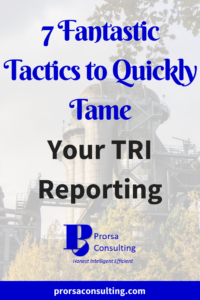7 Fantastic Tactics to Quickly Tame Your TRI Reporting
By : Admin -

Most environmental managers breathe a small sigh of relief about this time of year. You’ve completed most of your major annual reporting by now with the exception of your Toxic Release Inventory (TRI). The deadline for this report is just around the corner on July 1st. The 7 tactics outlined in this article should assist you in quickly taming TRI reporting, so you can get on to the important task of enjoying your summer.
Tactic 1: Know What’s New in TRI for the Report Year
Without fail some changes occur every TRI report year. Report Year 2017 (RY2017) is no different. Three important changes every environmental manager should know for this year’s reporting appear below:
- The 2017 North American Industry Classification System (NAICS) codes have been formally adopted. As such, the 2017 NAICS codes must be utilized in 2017 TRI data reports.
- Data on a new category, hexabromocyclododecane, must be included in the RY2017 TRI submissions.
- Several chemicals (listed below) had their de minimis levels updated from 1.0% to 0.1% due to recharacterizations under the OSHA carcinogen criteria:
- Cumene
- Diazinon
- 1,2-dichloropropane
- Malathion
- Methyl isobutyl ketone
- Parathion
- Sodium Pentachlorophenate
- 1,1,1,2-tetrachloroethane
- 1,1,2,2-tertachloroethane
Tactic 2: Check Your Site’s Inventory for Any New Substances Subject to TRI Reporting
This would seem like a no brainer, right? Hopefully, you already went through the exercise of checking your inventory for new chemicals before completing your Tier II reporting in March. In any case, you can reference the 2017 TRI List of Reportable Chemicals to double check if any new substances in your inventory are covered under TRI. If you had a new naturally occurring substance introduced for use at your site during 2017, please note that these substances usually have general exemption from TRI reporting.
Tactic 3: Make Certain Chemicals Have the Proper Activity Assignments and Know the Applicability Thresholds
Chemicals fall under three activities for TRI, and each has its own applicability threshold:
- If you produced, prepared, compounded, or imported a TRI chemical, then you manufactured the chemical at your site. The manufacture reporting threshold for a listed chemical is any amount over 25,000 pounds.
- If you prepared a listed chemical after manufacture for commercial distribution, you processed the chemical at your facility. The processing reporting threshold for a listed chemical is any amount over 25,000 pounds.
- If you used by any means a TRI chemical that would not be classified as manufactured or processed, then your site otherwise used the chemical. The otherwise used reporting threshold for a listed chemical is any amount over 10,000 pounds.
Tactic 4: Verify Your Source Data
To complete your calculations for threshold determinations and releases, chances are good you will be pulling data from a variety of sources. Reporters should be utilizing only their sites’ official data in these calculations to ensure accuracy and reproducibility. Moreover, you should be utilizing the same data used earlier in the year for your site’s other environmental reporting, such as GHG, emissions inventory, Tier II, etc. It’s not in the facility’s best interest to produce 2 environmental reports for the same report year with, as an example, differing production levels, if you get my drift.
Emissions factors serve as key components of your TRI calculations. These factors usually get overlooked from year to year, especially if you are utilizing an established protocol for estimation. It’s important to review whether any of the emission factors would have changed during the year due to new monitoring data or an update to any AP-42 factors you may utilize. Moreover, calculation schemes should incorporate any changes to facilitate accurate data reporting.
Tactic 5: Follow Established Calculation Methods for TRI
Sites have a choice of several methods for determining chemical quantities to be included in TRI reporting:
- Actual Monitoring
- Mass Balance
- Emission Factors
- Engineering Calculations
- Some Combination of the Above
While you can utilize any or all of these, the important thing here is to have a prescribed way to make the calculations for the facility. Sites should document their calculation methods in such a manner to facilitate reproduction of the threshold determinations and reported values if necessary. Moreover, facilities can minimize data variability over time with a consistent calculation strategy. Facilities should make changes when necessary. However, sites increase their reported data’s integrity when only necessary calculation modifications occur.
Tactic 6: Verify Access to EPA’s Central Data Exchange (CDX) Early & Submit Your Reports on Time
TRI reports must be submitted electronically through EPA’s CDX (https://cdx.epa.gov). If you are a new preparer then you must go through a registration process to gain access to the system. Additionally, new certifying officials must complete registration, have their identities successfully verified, and sign an electronic signature agreement before ever certifying a report. In the past, I have worked with individuals to complete this process and experienced issues.
Submittals for TRI are due on July 1st. Moreover, wait times for responses from the CDX Helpdesk tend to increase the closer you get to the deadline. So, I suggest you start early on making sure all affected persons have access to CDX. Sites should also consider starting ahead of time on the actual reporting itself. By beginning early, you have a better probability of getting the CDX support you may need should a problem arise. In addition, any issues that may materialize hopefully will not prevent you from submitting an on-time report.
Tactic 7: Know Where to Go for More Information
EPA has consolidated all TRI guidance, including Q&As, reporting instructions, and chemical/industry guidance documents, within GuideMe. If you have general questions on TRI, you can email tri.help@epa.gov for assistance. EPA’s TRI Program Page is a good place to start for overview information concerning TRI. Should you need a refresher on reporting your data within the system, the EPA has produced several TRI-ME Web tutorials to help you navigate around the TRI reporting function within CDX.
The Wrap Up
The TRI deadline is looming. The 7 tactics discussed in this post will get you well under way to ensuring successful, on-time TRI reporting for RY2017.
Prorsa Consulting is available to assist your facility with its EHS compliance, analysis, and management system needs. Give us a call or send us a message via our Contact Us page with any questions or feedback concerning our Services or blog.
If you found this information useful, be sure to like/and or share below! Don’t forget to subscribe to the Prorsa Consulting Newsletter to have updates emailed directly to your inbox. Also, you can follow Prorsa Consulting on Google+, LinkedIn, Pinterest, and Twitter for regular content updates.

